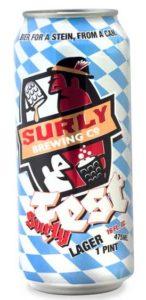Top 10 Märzen / Oktoberfest Beer Brewed in America
This Top Ten List of Oktoberfest Beers is from the results of the U.S. Open Beer Championship, Great American Beer Festival, and World Beer Cup. The best Oktoberfest beers are characterized by a medium body and broad range of color. They can range from golden to reddish orange. Sweet maltiness should dominate slightly over a clean, hop bitterness. Malt character should be light-toasted rather than strongly caramel. Bread or biscuit-like malt character is acceptable in aroma and flavor. Hop aroma and flavor should be low but notable. ABV: 5.1%-6.0%. IBU: 18-25. This list below comes from the medal winners of the Great American Beer Festival, the U.S. Open Beer Championship and RateBeer.com.

1. Surly SurlyFest – Surley Brewing – Minnesota
2. Das Umlaut – Flix Brewhouse – Indiana
3. Asheville Lager – Wedge Brewing – North Carolina
4. Marzen – Liquid Mechanics – Colorado
5. New Glarus Staghorn Octoberfest Beer – New Glarus Brewing – Wisconsin
6. Oktoberfest – Rahr & Sons Brewing – Texas
7. Great Lakes Oktoberfest – Great Lakes Brewing – Ohio
8. Oktoberfest – Beaver Island Brewing – Minnesota
9. Capital Oktoberfest – Capital Brewery – Wisconsin
10. Lobo Oktoberfest – Pedernales Brewing – Texas
History of Oktoberfest Beers
Oktoberfest, the world’s largest beer festival, began in 1810 in Munich, Germany, to celebrate the marriage of Crown Prince Ludwig and Princess Therese. The event featured horse races and communal festivities, but beer quickly became a centerpiece due to Bavaria’s rich brewing tradition. Early Oktoberfest beers were likely darker, malt-heavy brews, reflecting the styles popular in the region at the time, such as Dunkels or Märzen, a robust, amber lager brewed in March and stored through summer for fall consumption. These beers were crafted by Munich’s prominent breweries, like Spaten, Augustiner, and Paulaner, which adhered to the 1516 Reinheitsgebot, ensuring purity with only water, barley, and hops (yeast was later included). By the mid-19th century, Märzen became the festival’s signature beer, valued for its balanced maltiness and drinkability during the multi-day celebration.
As Oktoberfest grew into a global phenomenon, the beer evolved to suit changing tastes and brewing innovations. By the late 20th century, the darker, heavier Märzen was largely replaced by a lighter, golden-hued style known as Festbier, pioneered by Paulaner in the 1970s. Festbier offered a crisper, more approachable flavor with a similar alcohol content (around 5-6%), making it ideal for mass consumption during the festival’s raucous atmosphere. Today, only six Munich breweries—Augustiner, Hacker-Pschorr, Hofbräuhaus, Löwenbräu, Paulaner, and Spaten—are permitted to serve beer at Oktoberfest, each producing Festbier or Märzen-style beers that adhere to strict festival standards. These beers remain a symbol of Bavarian heritage, blending centuries-old tradition with modern brewing techniques to delight millions of festivalgoers annually.
Top 10 Beers in America – Ales Lagers Specialty Barrel Aged